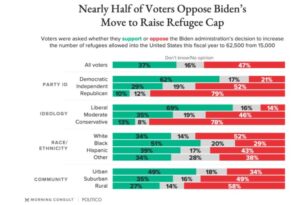At Daily Kos, Aldous J. Pennyfarthing notes a new poll Democrats will find concerning, and comments:
Millions of people just live their lives, blissfully ignorant of the minutiae that go into spending bills meant to benefit them directly. They got their Biden Bucks, but they don’t necessarily know whom to credit.
To wit: $300 monthly child tax credits will start landing in people’s bank accounts in July, and most people have already gotten their $1,400 stimulus payments. While this much-needed relief is the work of Joe Biden and congressional Democrats (exclusively Democrats, in fact), not everyone in rural America has grokked what the Democratic Party has done for them.
Pennyfarthing quotes from a Washington Post report on the poll:
A new poll of rural voters, commissioned by a super PAC that seeks to build support for Democrats in rural areas, underscores the point: It finds that a large percentage of rural voters in battleground states are not ascribing credit for stimulus payments to the Democratic Party.
The poll, which was conducted by YouGov for Rural Objective PAC, finds that only 50 percent of those rural voters associate “providing stimulus checks directly to families and workers” with the Democratic Party.
Meanwhile, 32 percent of those rural voters associate this with the GOP, and another 11 percent associate it with neither party. That’s a total of 43 percent who don’t associate it with Democrats.
“We’re not connecting with these voters, even if we have great policy,” J.D. Scholten, executive director of Rural Objective PAC, told the Post.
The poll also found that 68% of the rural voters surveyed supported the stimulus checks, but they’re not necessarily crediting Democrats.
The messaging problems don’t end there, of course. Despite a consistent push from Democrats to get rural areas outfitted with broadband—an initiative that’s strongly reflected in Biden’s infrastructure proposals—only 42% of rural voters associate broadband investments with Democrats, whereas 25% credit Republicans.
How can this be? Well, there are at least two big reasons for it.
First of all, because they have no shame nor honor, Republicans have been scrambling to take credit for Biden’s American Rescue Plan, which every single one of them voted against.
Pennyfarthing cites some examples of Republicans actually claiming credit for Democratic reforms, and adds:
There are so many more. Since Republicans are rarely punished by their “traditional values” voters for lying (which, to be fair, is a longstanding Republican tradition), it appears that they’re getting away with it.
Circling back to reasons why rural voters are crediting the GOP for the American Rescue Plan, people tend to underestimate exactly how much government help they actually get….We need to keep reminding folks that Democrats are better for their pocketbooks—and that this advantage isn’t limited to stimulus payments and infrastructure proposals. The past several decades prove that Democratic presidents—and policies—are better for the economy than Republican presidents, no matter what measure you look at.
If we can convince enough rural voters in purple states like Wisconsin, Pennsylvania, and Arizona that Democrats are the ones who are actually on their side, maybe we can keep those states in the blue column for the foreseeable future.
Joe Biden’s policies are popular. We just have to make sure everyone knows they’re Democratic policies, or we’ll eventually cede control to a passel of lying scoundrels who want to spend the rest of their lives pissing on the heads of their constituents … while telling them it’s Trump Champagne.
Republicans have benefitted from messages du jour re-branding the Democratic Party in a negative light. With few exceptions, however, Democratic ads focus on candidates, but rarely on the differences between the two parties. It’s not enough for a party to have great policies. Democrats need to declare an all-out campaign to claim credit for their popular policies.









